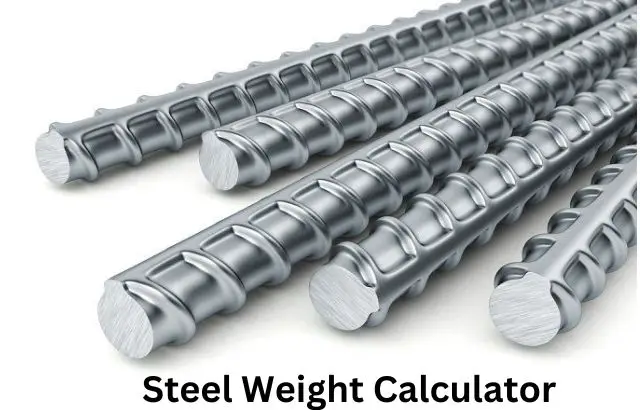Steel Weight Calculator | Calculate Metal Weight by Shape
Articles, products, and services offered on this site are for informational purposes only. We are part of the Amazon Services LLC Associates Program, an affiliate advertising program. Amazon.com is compensated for sales resulting from links on our website.
Please review our disclaimer before acting based on anything you read or see.
As we all know, steel is one of the most popular building materials. It is equally crucial to determine the steel bar’s unit weight before using it. Thus, we have made this post on the Steel Weight Calculator.
The primary usage of steel bars is as reinforcement to increase the tensile strength of concrete constructions. You want material for your metal project that is within your budget, functional, and aesthetically pleasing. This implies that some parameters must be considered, such as the material’s strength, damage tolerance, and malleability.
However, weight is one of the most crucial things to consider since it impacts several aspects, including cost and portability. We’ve emphasized ways to determine steel’s weight below. This will be possible through the use of the Steel Weight Calculator. Come along as we highlight more on this below.
Steel Weight Calculator
What is Steel Weight?
The weight of steel is often expressed in kilograms, tons, and pounds. Different steel diameters are used in construction. They have the following dimensions: 8, 10, 12, 16, 20, 25, 32, and 40 mm.
For typical residential, commercial, and office building development, steel diameter ranges from 8 mm to 20 mm.
Arches, dams, and retaining walls are among the major construction projects that require steel with a diameter of 25 mm to 40 mm.
How to Calculate the Weight of Steel?
The steps listed below may be used to determine the weight of steel:
Choose the relevant sector.
Finding the steel product’s cross-area sections should be your initial step. This may be done by simply dividing the cross-width sections by their height. The measurement must be in millimeters square (mm2).
Work out the length
The dimension of your steel product should then be determined and expressed in meters (m).
Figure out the density
The density of your steel, defined as its mass per unit of volume, is the third quantity you must ascertain. For instance, if a substance has a density of 7.5 g/cm3, it signifies 7.5 grams of mass in every cubic centimeter of the substance. Depending on the quality, stainless steel’s density varies from 7.7 to 8 g/cm3.
Figure out the weight
You may calculate the weight of your steel using the following formula after you know the data for its sectional area, length, and density:
Fractional Area (mm2) x Length (m) x Compression (g/cm3) x 1/1,000 = Weight (kg).
You will collectively maximize the sectional area, length, and density to determine the weight of your steel. The product must then be divided by 1,000 to convert the weight to kilograms.
Different Types of Weight of Steel
The Different Types of Weight of Steel that are used in construction industries include:
Mild steel plain bars
The first forms of bars utilized in the building business are mild steel plain bars. As the name suggests, these bars have a smooth, round exterior instead of misshapen ones. These sorts of bars are very weak in the tensile department. They are often employed in modest infrastructure projects where less shear test is needed.
Hot rolled deformed bars
As the name implies, these bars are created using a hot rolling method, in which the surface of the bars is given a distorted shape, such as ribs, which eventually aids in forming a connection with the concrete. These are now the most prevalent bars used in structural reinforcement. They have an impressive 60000 psi tensile strength.
TMT bars
TMT means “Thermal Mechanical Treatment,” The most popular TMT bars nowadays for building engineering are Fe 500 and Fe 500D. The features of TMT steel include anti-corrosion, strong seismic resistance, low weight, and ease of assembly.
Cold-worked steel bars
As their name implies, these bars are produced by a cold working technique in which they are first hot-rolled and then cold-rolled. These kinds of bars are subjected to twisting and turning at room temperature, which lessens their ductility.
Prestressing steel bars
Steel reinforcement bars, known as prestressing steel bars, are employed as filaments or tendons. Several strands of concrete are required to execute the prestressing activity in the structure. The bundles of wire, such as 2 or 3, or 7 wire strands, make up the strands. Cold-formed wires are employed in the prestressing. Their tensile strength ranges from 250000 to 270000 psi.
Why is steel weight important?
Steel weight is significant because it determines the stability of structures and infrastructure. More than 50% of the world’s steel demand is accounted for by one of the most significant steel-using industries: infrastructure.
Steel provides the strength that all structures — from homes to parking garages to schools and skyscrapers — need. It is also utilized as cladding for external walls and roofs.
Steel producers all around the globe are progressively offering building solutions that allow for energy-efficient and carbon-neutral structures. Steel is less expensive, more accessible, and safer. Additionally, its inherent qualities—such as strength, adaptability, durability, and 100% recyclable nature—allow for superior environmental performance throughout a building’s full life cycle.
Numerous adjacent sectors also employ cutting-edge high-strength steels used in steel-plate applications. All of these applications benefit from the qualities of contemporary steel strength, including offshore oil rigs, bridges, civil design, construction equipment, train carriages, tanks and compressed gases, and nuclear, thermal, and hydroelectric facilities.
What Quantity of Material Do You Need?
The cost of steel-related projects may vary significantly depending on various variables. In actuality, even day-to-day fluctuations in price might be significant. The right measures must be taken to create an estimate to arrive at an accurate cost for any project requiring steel.
The following are some of the variables that may affect the total amount of your steel job:

The job’s requirements
The amount will be crucial in your cost estimates since steel is often priced out depending on its weight. It will help if you exercise extra care while determining the dimensions for the quantity of steel you will need to do the project. For example, the W 6 x 25 steel requirement, 6 inches deep and 25 lb/ft in weight, is the industry standard in America for girder bridge beams.
The kinds of equipment and materials
Your project will probably need several more tools and supplies and the steel to be completed. All the essential castings, fittings, fasteners, tools, and other items must be considered when creating your pricing estimate. Remember to include any disposable items in your estimate since they might be an important part of it.
Essential finishes
Depending on the project type, you can want to attain several sorts of steel finishes. Certain tasks call for various finishes. The methods required to obtain these finishes often significantly increase any project’s cost.
Why use our metal weight calculator?
You may use our metal weight calculator to determine the weight of any quantity of metal. This is helpful if you want to move substantial metal components. This will enable you to determine if your vehicle can withstand the weight or how much it will cost to transport the pieces to your preferred location.
Many variables are available on our metal weight calculator regarding forms and alloys. It may be used to determine the weight of less common materials like manganese or beryllium and more common metals like steel or aluminum.
Frequently Asked Questions
What is the weight of steel?
A cubic inch of steel weighs 0.2833 pounds.
How do you find the density of steel?
By splitting the object’s mass by volume, we may get the density of the metal. The item would have a density of 0.284 per cubic inch if its mass were 7.952 pounds and its volume was 28 cubic inches.
How can I calculate weight?
Weight is a gauge of how strongly gravity is dragging something down. It relies on the mass of the item and the acceleration brought on by gravity, which on earth is 9.8 m/s2. F = m 9.8 m/s2 is the formula for computing weight, where m is the object’s mass in kilos and N is the object’s weight in Newtons (N).
What is the weight formula?
We use the generic formula shown below to compute weight:
W = mg. Where “W” stands for the object’s weight, “m” for its mass, and “g” for the acceleration brought on by gravity. The value of g on earth is 9.8 m/s2.
How do you calculate steel quantity?
To achieve this, multiply the steel’s cross-sectional area by its overall length and steel’s density, which is 7850 kg/m3. The sum of the primary steel and stirrup steels makes up the total steel in a pillar.
Does weight sell steel?
Yes. Steel is normally priced per hundredweight (CWT), or the cost per material weight of 100 pounds. Carbon steel price may be shown per pound in some circumstances, such as materials market reports.
What is steel density?
The density of plain steel is about 490 tons per cubic foot or 7.85 grams per cubic centimeter. About 7.84 g/cm3 is the density of carbon steel, 7.86 g/cm3 is that of pure iron, and 8.03 g/cm3 is that of stainless steel.
Expert Opinion
Steel is an alloy that is made up of iron to make it more durable and less susceptible to breakage than other types of iron. It often contains a few tenths of a percent of carbon. Many other components might be included or added.
A steel weight calculator is a useful tool for calculating steel weight nowadays. The calculator will determine the weight of your steel material after you enter the dimensions and kind of metal.



Comments are closed.